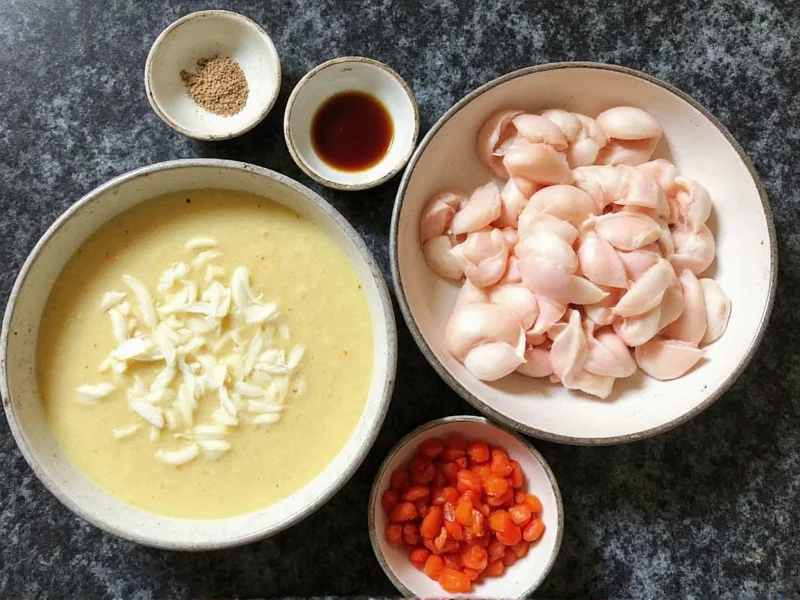Egg drop soup, known as dan hua tang in Chinese cuisine, represents one of the simplest yet most elegant dishes in the culinary repertoire. The magic happens when just a few carefully selected ingredients combine through precise temperature control and technique. While regional variations exist across Chinese communities, the foundation remains remarkably consistent.
Core Components of Authentic Egg Drop Soup
Understanding what makes egg drop soup distinct requires examining each element's role in creating the final dish. The interplay between liquid base, egg preparation, and thickening agent determines whether you achieve restaurant-quality results or a disappointing curdled mess.
| Ingredient | Traditional Amount | Primary Function |
|---|---|---|
| Chicken broth | 4 cups | Flavor foundation and liquid base |
| Eggs | 2 large | Creates signature ribbons when tempered |
| Cornstarch | 1-2 tablespoons | Provides subtle thickening without heaviness |
| Fresh ginger | 1-inch piece | Adds aromatic warmth and authentic flavor |
| Green onions | 2 stalks | Provides fresh contrast and visual appeal |
Why These Egg Drop Soup Main Ingredients Matter
The simplicity of egg drop soup makes ingredient quality critically important. Unlike complex dishes where flavors blend, each component here must shine through clearly. Traditional Chinese cooking emphasizes xian wei (鲜味), or umami richness, which comes primarily from the broth quality.
Broth Selection: The Flavor Foundation
While many home cooks use store-bought chicken broth, authentic preparation begins with simmering chicken bones for hours to extract collagen and natural gelatin. This creates the subtle viscosity that allows egg ribbons to form properly. For vegetarian egg drop soup ingredients, mushroom or kombu broth provides comparable umami depth without animal products.
Egg Technique: More Than Just an Ingredient
The eggs in egg drop soup serve as both ingredient and technique. Room temperature eggs whisked until just combined (not frothy) create the most delicate ribbons. The critical moment comes when slowly drizzling beaten eggs into gently simmering broth while stirring in one direction. This traditional Chinese cooking method prevents scrambling and produces the signature wispy strands.
Thickening Agent Science
Cornstarch serves a dual purpose in egg drop soup main ingredients: it provides subtle body while protecting the eggs from curdling. The starch molecules surround egg proteins during cooking, preventing them from bonding too tightly. Some regional variations use potato starch or arrowroot, but cornstarch remains the most accessible option for achieving that perfect silky consistency without heaviness.
Traditional Preparation Method
Authentic preparation follows a precise sequence that maximizes flavor development while protecting delicate ingredients. First, ginger simmers in broth for 10-15 minutes to infuse flavor without becoming bitter. The cornstarch slurry (cornstarch mixed with cold water) gets added off-heat to prevent lumps, then brought to a gentle simmer. Only when the broth reaches 180°F (82°C) should you add the eggs in a slow, steady stream while stirring continuously in one direction.
Common Variations and Optional Additions
While purists argue that true egg drop soup contains only the essential components, many households incorporate additional elements:
- White pepper - Adds subtle heat without visible specks
- Sesame oil - A few drops finish the soup with nutty aroma
- Shaoxing wine - 1 teaspoon enhances depth of flavor
- Wood ear mushrooms - Provide textural contrast in some regional versions
These additions transform the simple egg drop soup main ingredients into more complex variations, but the core trio remains unchanged across all authentic preparations.
Perfecting Your Egg Drop Soup Technique
Even with perfect egg drop soup ingredients, technique determines success. The broth must maintain a gentle simmer—not a rolling boil—as you add the eggs. Temperature control proves crucial; too hot and the eggs scramble, too cool and they won't form ribbons. Many professional chefs use a technique called zou huo (走火), or "walking fire," where they remove the pot from heat just before adding eggs, allowing residual heat to cook them gently.
For those seeking gluten-free egg drop soup main ingredients, cornstarch provides the ideal thickener. Those avoiding chicken broth can achieve excellent results with mushroom or kombu-based vegetarian alternatives that still deliver the necessary umami foundation.
Troubleshooting Common Issues
Understanding why certain problems occur helps refine your approach to this deceptively simple dish:
- Curdled eggs - Usually caused by broth that's too hot or adding eggs too quickly
- Thin, watery texture - Insufficient cornstarch or improper slurry preparation
- Bland flavor - Inadequate broth quality or insufficient ginger infusion time
- Cloudy appearance - Over-stirring after adding eggs or using low-quality broth











 浙公网安备
33010002000092号
浙公网安备
33010002000092号 浙B2-20120091-4
浙B2-20120091-4